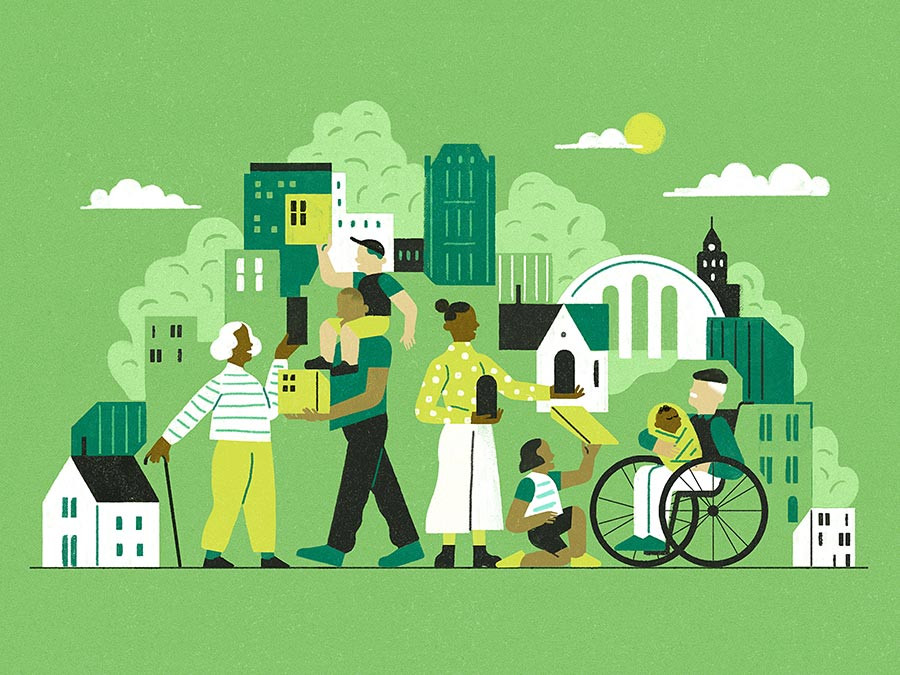 (Illustration by Gracia Lam)
(Illustration by Gracia Lam)
The cost of higher education in the United States is a major barrier to entry, especially for racial and ethnic minorities and for students who are the first generation in their families to attend college. National student loan debt amounts to more than $1.6 trillion, with more than 45 million borrowers. On top of this, many graduate students carrying college debt while pursuing advanced degrees can’t find affordable housing, partly because most university dorms lack space for them.
Older adults—many of whom live near universities—also face increasing debt and the need for affordable housing. The median debt among adults over age 60 in the United States increased to $31,050 in 2016—a 23 percent jump from 1989. And, according to federal data analyzed by the Urban Institute, some 9.18 million American homeowners over age 65 had mortgage debt in 2019, up nearly 60 percent from 5.82 million a decade ago. As other essays in this series point out, many older adults who want to age in place can’t afford their housing costs and stand to benefit from renting spare rooms in their homes to young adults.

Overcoming Housing Insecurity
To begin addressing these challenges, our team at New York University’s Center for Health and Aging Innovation launched an intergenerational housing program in 2018 to promote housing and economic security among graduate students and older adults, reduce social isolation, and foster cross-generational cohesion. The program—which reflects the university’s efforts over the past five years to bolster college affordability, and prioritize equity and aging—intentionally recruits first-generation students, racial and ethnic minorities, women, and individuals who live alone to share housing.
Older adults have reported that they are confident and comfortable opening their homes to students who belong to an academic institution anchored in the community, and feel a sense of security knowing they can directly reach out and talk to a university employee, especially in the social work department. The program has so far referred about a dozen graduate students to New York Foundation for Senior Citizens, a longstanding community partner that has ironed out legal risks, and provided a well-tested algorithm to match students and older adults on preferences such as smoking, pets, geographic location, and cost. Some students save hundreds of dollars per month on housing costs, while both benefit from friendships.
Other colleges and universities in the United States that have launched intergenerational housing programs include Washington University in St. Louis, which places students studying social work in their own apartments within the assisted living facility. Students forego paying rent in exchange for organizing social activities for older adults. Another example is the Brookdale Center for Aging at Hunter College, which has not yet quite launched (due to COVID-19) but aims to identify low-income, older neighbors in Harlem, New York, who may want to rent to graduate students.
Given the emerging and growing interest among universities in intergenerational home-sharing, Generations United has led an effort to bring faculty and practitioners together to share lessons and effective tools. There are approximately two-dozen universities and community-based organizations across the United States—spanning from Hawai’i to New York City—to help establish and scale these kinds of programs. The following three insights have proved particularly useful:
1. Align Interpersonal Expectations
Many older adults who choose to rent space to graduate students want to mentor, nurture, and develop friendships with them. Typically, they are careful about who they accept into their home and want to make every moment count. By contrast, graduate students are primarily motivated by the prospect of lower rent and having their own living space close to campus, and they generally have an experimental attitude about the program. It’s important that programs align the expectations of each group from the beginning.
Our program at New York University taught us that the matching process between older adults and students needs to take into account that developing identity, independence, and passions are critical to young adults and that older adults need to respect clear boundaries. For example, when a woman of color in her 70s decided to join our program, she sought a female graduate student of color who she could mentor. Although the student we identified seemed an excellent match at first, she strongly desired independence, and ultimately found the homeowner’s desire to mentor her intrusive and parental. Within a semester, she discontinued the program and moved in with peers her age, even though her new rental was further away from campus and more costly.
We’ve since modified recruitment materials to emphasize the goals of building friendships and community, rather than the transactional aspects of the program. As a result, we are recruiting students who want relationships with older homeowners, rather than just affordable rent. A friendship emerged between one international graduate student and his older roommate in our program, for example, after they found a balance between respecting one another’s need for independence and sharing responsibility for household chores.
2. Understand the Meaning of Home
The tension between older and younger adults regarding shared space is often palpable. Older adults often have a deep attachment to places, family, friends, and neighbors who have played an important part in their life’s journey. Many objects in their homes are tied to memories, emotions, and identity, and carry symbolic meaning. On the other hand, one of the most common complaints among students is the lack of opportunity to make the space in the home they share their own. Mitigating this tension requires that programs develop interview training on how to evaluate applicants, and perform close assessments of the home and regular check-ins to see how the relationships are developing. For example, some bedrooms are outfitted with beds appropriate for a child but not a college student. It is also helpful to talk to older adults up front about how to make space—conceptually and tangibly—for students in their homes.
This sometimes requires a conversation with an older homeowner on what it means to clear out a bedroom—a room that a spouse who passed away once used as an office or that belonged to a child who moved out. Very often, prospective hosts are women, widowed, and we talk with them about the loss of their spouse, how it has changed the meaning of home, and what the next phase of their life looks like. These conversations are about letting go of a unique life stage; acknowledging, respecting, and cherishing partners and their memories; and understanding the need to make space for someone new in their lives.
To support students, we offer a small stipend of $500 to purchase furniture they feel is essential to their identity and academic performance, such as a larger bed, a suitable desk, or wall art. One student bought a small refrigerator to keep in his bedroom so that there was no risk of his roommate accidentally consuming his most coveted food and beverages.
3. Navigate the Policy Barriers
Finally, the threat of losing health and other public benefits is a major concern among low-income, older adults and those who live in public housing. The exchange of services or receipt of income also jeopardizes their eligibility for programs like Supplementary Security Income (SSI), the Supplemental Nutrition Assistance Program (SNAP), Medicaid, and Senior Citizen Rent Increase Exemption. Many also face restrictions on household structure and other municipal policies that prevent them from renting rooms to graduate students. These barriers make it prudent in many cases to target older adults who don’t qualify for most of these government programs, but who nevertheless struggle financially and need extra income. But university home-sharing programs should also work to remove policy barriers where they can.
We have just started to discuss these issues with policy makers at the Department for the Aging in New York City and the Age Strong Commission in Boston, as well as the cities’ mayors, with the hope of categorizing home-sharing contributions and services as exemptions to taxable income. And US Senator Ron Wyden of Oregon has recently expressed interest in changing federal policies to enhance intergenerational home-sharing. Efforts to work with policy makers need to continue, we need more evidence of positive co-housing outcomes across generations to modify current legislation.
Unique Challenges, Big Payoffs
The promise of intergenerational home-sharing has yet to be fully realized. While it poses unique challenges tied to the distinct economic, social, and psychological needs of young adults and older residents, there are promising solutions such as refining the match, setting clear boundaries, and sharing evidence with policymakers on barriers as well benefits of these programs. We are inspired by the successful matches in our program and determined to identify ways to scale these experiences to promote affordable education, housing, and a greater sense of community across generations.
Support SSIR’s coverage of cross-sector solutions to global challenges.
Help us further the reach of innovative ideas. Donate today.
Read more stories by Ernest Gonzales.

